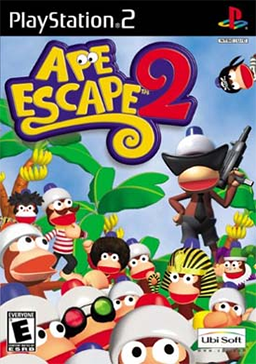
Ape Escape 2 is a 2002 platform game developed and published by Sony Computer Entertainment for the PlayStation 2. It was released in Japan in July 2002, Europe in March 2003 and North America in July 2003 by Ubi Soft. It is the second main installment of the Ape Escape series, and the second game in the series to be on the PlayStation 2 after Pipo Saru 2001. It was also used as the basis for the animated series by Frederator Studios.
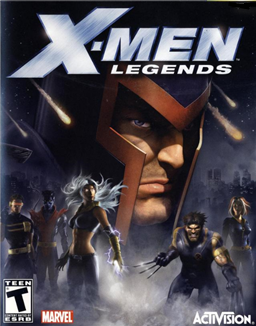
X-Men Legends is an action role-playing video game developed by Raven Software and published by Activision. It was released on the GameCube, PlayStation 2 and Xbox consoles in 2004. Barking Lizards Technologies developed the N-Gage port of the game, which was released in early 2005. Players can play as one of fifteen X-Men characters, with the ability to switch between four computer- or human-controlled characters at any time.
Ape Escape -On Air- is a CGI anime television series produced by Xebec based on Sony's Ape Escape video game franchise. The series and its sequel aired on TV Tokyo between April 8, 2006 and September 29, 2007, and loosely adapt storylines from Million Monkeys, Ape Escape 3, and SaruSaru Big Mission.
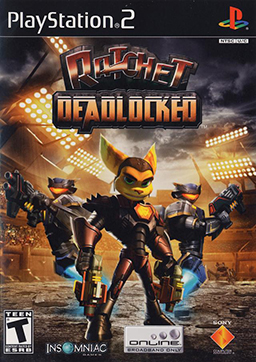
Ratchet: Deadlocked is a 2005 third-person shooter platformer, developed by Insomniac Games and published by Sony Computer Entertainment for the PlayStation 2 as the fourth installment of the Ratchet & Clank series.

Ape Escape: Pumped & Primed is a 2004 party video game developed and published by Sony Computer Entertainment for the PlayStation 2. It is a spin-off of the Ape Escape series and the final installment in the series to be released by Ubisoft in North America. It was never released in Europe, despite being advertised in the United Kingdom and Australia.

Teenage Mutant Ninja Turtles, known as Geki Kame Ninja Den in Japan and Teenage Mutant Hero Turtles in Europe, is a 1989 action-platform game developed and published by Konami for the Nintendo Entertainment System. In North America it was published under Konami's Ultra Games imprint in the US and the equivalent PALCOM brand in Europe and Australia.

Ape Escape is a series of video games developed primarily by Japan Studio and published and owned by Sony Interactive Entertainment. The series incorporates ape-related humour, unique gameplay, and a wide variety of pop culture references. The first game in the series is the first game to require the DualShock or Dual Analog controller to play.
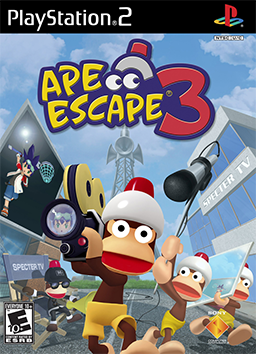
Ape Escape 3 is a 2005 platform video game developed and published by Sony Computer Entertainment for the PlayStation 2.
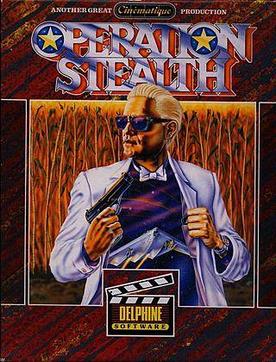
Operation Stealth, also known as James Bond 007: The Stealth Affair in the United States, is an adventure game from Delphine Software International, released in 1990. The game is mainly the work of Paul Cuisset (programming) and Jean Baudlot (sound).

SpongeBob SquarePants: Creature from the Krusty Krab is an action-adventure platform game released for Microsoft Windows, Game Boy Advance, GameCube, PlayStation 2, Nintendo DS and Wii by THQ. An Xbox version may have been planned at some point, but was cancelled for unknown reasons. The PS2, GameCube, and Wii versions are all ports of the same game developed by Blitz Games, while the Game Boy Advance, Nintendo DS, and PC versions were separate games developed by WayForward Technologies and AWE Games respectively. It is based on the Nickelodeon animated sitcom SpongeBob SquarePants, and stars the title character, his best friend Patrick Star and their enemy Plankton as they journey to nine different worlds, supposedly inside the dreams of the characters. The Wii version was a North American launch title. It is also the first SpongeBob game released in Japan, but was released under the title SpongeBob, to mark it as the first video game in the SpongeBob series to have a Japanese release. The PC version of the game is titled SpongeBob SquarePants: Nighty Nightmare.
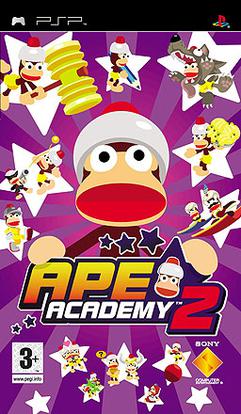
Ape Academy 2, also known as Piposaru Academia 2: Aiai Sarugē Janken Battle! in Japan, is a party video game developed by Shift and Alvion and published by Sony Computer Entertainment for the PlayStation Portable. It is the sequel to Ape Escape Academy.

Ratchet & Clank Future: Tools of Destruction is a 2007 action-adventure platform game developed by Insomniac Games and published by Sony Computer Entertainment for the PlayStation 3. It is the fifth main installment of the Ratchet & Clank series, following the spin-off Ratchet & Clank: Size Matters. The game was released on October 23, 2007 in North America and on November 9, 2007 in Europe. It is the first PlayStation 3 installment of the series, as well as the first of the Future saga. It was also one of the first PlayStation 3 games to support DualShock 3 rumble without any accessories.

Monkey Puncher is a video game for the Game Boy Color, developed by Taito, and released in December 2000. The game's goal is to train a monkey to fight in organised boxing matches in order to save the main character's father and sibling.

Last Armageddon is a 1988 post-apocalyptic role-playing video game for the NEC PC-8801, MSX, Sharp X68000, MS-DOS, PC Engine CD-ROM², and Nintendo Family Computer. The game was exclusively in the Japanese language until an English translation patch was created for the Nintendo Famicom.

Saru Get You: SaruSaru Big Mission is a platform video game developed by h.a.n.d. and published by Sony Computer Entertainment for the PlayStation Portable. A spin-off of the Ape Escape series, it was released only in Japan.

Pipo Saru 2001 is a 2001 action video game developed and published by Sony Computer Entertainment for the PlayStation 2. A spin-off and the second game in the Ape Escape series, it was released only in Japan; a true sequel, Ape Escape 2, was released internationally for the PlayStation 2 in 2002.

Ape Escape is a series of animated shorts developed by Frederator Studios, Hawaii Film Partners, Project 51 Productions and Showcase Entertainment which aired on Nicktoons in 2009. It is based on Sony Computer Entertainment's Ape Escape video game franchise, with characters and designs based on Ape Escape 2 in particular, and focuses around Specter's attempts to take over the world with his monkey army.

Ape Escape is a 1999 platform game developed and published by Sony Computer Entertainment for the PlayStation. The first game in the Ape Escape series, the game tells the story of an ape named Specter who gains enhanced intelligence and a malevolent streak through the use of an experimental helmet. Specter produces an army of apes, which he sends through time in an attempt to rewrite history. Spike, the player character, sets out to capture the apes with the aid of special gadgets.

PlayStation Move Ape Escape, simply titled Ape Escape in Europe and known in Asian countries as Ape Escape: On the Move!, and in Japan as Furi Furi! Saru Get You, is a 2010 rail shooter and party video game developed by Japan Studio and published by Sony Computer Entertainment for the PlayStation 3. The game was originally announced at the Tokyo Game Show 2009 as one of the title supporting the PlayStation Move controller. The title was released on December 9, 2010, in Japan, then in 2011 on June 24 for Europe, and on July 5 for North America. An English version of the game in Asia was also released January 31, 2011.
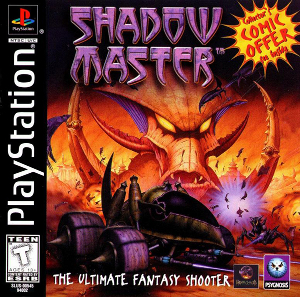
Shadow Master is a video game developed by HammerHead and published by Psygnosis for the PlayStation and Microsoft Windows. It is a first-person shooter in which the player character rides in an armed vehicle. It met with predominantly negative reviews which praised its visuals but criticized it for clunky controls and poorly designed, frustrating gameplay.



















